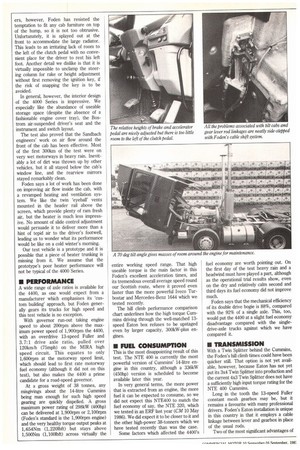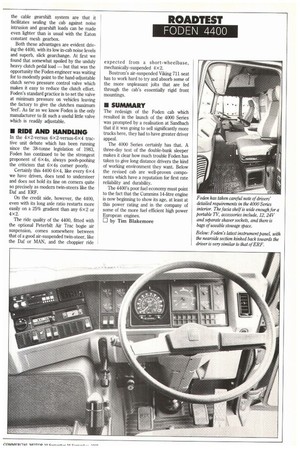BIG-CAB HYBRID SETS THE PACE
Page 36

Page 37

Page 38

Page 39

If you've noticed an error in this article please click here to report it so we can fix it.
II No other manufacturer combines European and American truck engineering practices — and well-proven truck technology with new ideas — in quite the same way as Foden.
The specification of our test vehicle, the first of the new 4000 Series to be fully road tested anywhere, is a case in point. Its driveline, for example, comes from American companies with British manufacturing bases, Cummins and Eaton, and will be familiar to many British operators.
The 4000 Series cab, with its heavily revised front and interior, was introduced only a matter of months ago and still turns drivers' heads. While the influence of American, Paccar-style engineering is much in evidence on the tractive unit's chassis, driveline and suspension, the cab is pure European. It displays the kind of attention to driver comfort within restricted overall dimensions that was, until recently, conspicuously lacking from American manufacturers.
Comparing and contrasting an AngloAmerican hybrid like the 4400 5106 with European trucks of more homogeneous origins during a three-day roadtest is a fascinating exercise. different enough from the old to warrant any changes, hence the retention of the S104/S106/S108 designations. From the A-posts back, the 4000 Series cab (the number was chosen because this is the fourth generation model since Paccar's takeover of Foden in 1980) comprises much the same steel cab frame with aluminium doors and GRP panels as the old S10 cab, but the interior has been extensively revised. The front of the cab, from the A-post forwards, has been completely changed. The strongest first impression, and an abiding one, after climbing into the 4000 Series driver's seat is of vast interior space.
Our test vehicle is the high-roof, double-bunk model with enough interior height to allow a driver to stand upright on the engine cover, but it is not simply the extra roof height which gives the impression of spaciousness.
The 4000 Series' windscreen is about 150mm further forward than that of the old S10 so there is more room in front of the driver, and the screen itself is bigger. A light grey interior trim adds to the impression of space, but such a light colour may be hard to keep clean.
Foden's new cab is not mounted particularly high, so the relatively tall 14-litre Cummins engine causes a fairly high centre hump. Unlike some other manufacturers, however, Foden has resisted the temptation to fit any cab furniture on top of the hump, so it is not too obtrusive. ers, however, Foden has resisted the temptation to fit any cab furniture on top of the hump, so it is not too obtrusive. Unfortunately, it is splayed out at the front to accommodate the large radiator. This leads to an irritating lack of room to the left of the clutch pedal with no convenient place for the driver to rest his left foot. Another detail we dislike is that it is virtually impossible to unclamp the steering column for rake or height adjustment without first removing the ignition key, if the risk of snapping the key is to be avoided.
In general, however, the interior design of the 4000 Series is impressive. We especially like the abundance of useable storage space (despite the absence of a fashionable engine cover tray), the Bostrom air-suspended driver's seat and the instrument and switch layout.
The test also proved that the Sandbach engineers' work on air flow around the front of the cab has been effective. Most of the first 300Icm of the test were on very wet motorways in heavy rain. Inevitably a lot of dirt was thrown up by other vehicles, but it all stayed below the cab's window line, and the rearview mirrors stayed remarkably clean.
Foden says a lot of work has been done on improving air flow inside the cab, with a revamped heating and ventilation system. We like the twin 'eyeball' vents mounted in the header rail above the screen, which provide plenty of ram fresh air, but the heater is much less impressive. No amount of slide control adjustment would persuade it to deliver more than a hint of tepid air to the driver's footwell, leading us to wonder what its performance would be like on a cold winter's morning.
Our test vehicle is a prototype and it is possible that a piece of heater trunking is missing from it. We assume that the prototype's poor heater performance will not be typical of the 4000 Series.
A wide range of axle ratios is available for the 4400, as one would expect from a manufacturer which emphasises its 'custom building' approach, but Foden generally gears its trucks for high speed and this test vehicle is no exception.
With governor run-out taking engine speed to about 200rpm above the maximum power speed of 1,900rpm the 4400, with an overdrive 13-speed Fuller and 3.7:1 drive axle ratio, pulled over 120km/h (75mph) on the MIRA high speed circuit. This equates to only 1,600rpm at the motorway speed limit, which should lead to first rate motorway fuel economy (although it did not on this test), but also makes the 4400 a prime candidate for a road-speed governor.
At a gross weight of 38 tonnes, any misgivings about the 14-litre Cummins being man enough for such high speed gearing are quickly dispelled. A gross maximum power rating of 298kW (400hp) can be delivered at 1,900rpm or 2,100rpm (Foden's standard is the 1,900rpm engine) and the very healthy torque output peaks at 1,654Nm (1,220Ibft) but stays above 1,500Nm (1,1001ft) across virtually the entire working speed range. That high useable torque is the main factor in this Foden's excellent acceleration times, and its tremendous overall average speed round our Scottish route, where it proved even faster than the more powerful Iveco Turbostar and Mercedes-Benz 1644 which we tested recently.
The hill climb performance comparison chart underlines how the high torque Cummins driving through the well-matched 13speed Eaton box refuses to be upstaged even by larger capacity, 300kW-plus engines.
This is the most disappointing result of this test. The NTE 400 is currently the most powerful version of Cummins' 14-litre engine in this country, although a 336kW (450hp) version is scheduled to become available later this year.
In very general terms, the more power that is extracted from an engine, the more fuel it can be expected to consume, so we did not expect this NTE400 to match the fuel economy of say, the NTE 320, which we tested in an ERF last year (CM 10 May 1986). We did expect it to be closer to it and the other high-power 38-tonners which we have tested recently than was the case.
Some factors which affected the 4400's fuel economy are worth pointing out. On the first day of the test heavy rain and a headwind must have played a part, although as the operational trial results show, even on the dry and relatively calm second and third days its fuel economy did not improve much.
Foden says that the mechanical efficiency of its double drive bogie is 88%, compared with the 92% of a single axle. This, too, would put the 4400 at a slight fuel economy disadvantage compared with the singledrive-axle trucks against which we have compared it.
With a Twin Splitter behind the Cummins, the Foden's hill climb times could have been quicker still. That option is not yet available, however, because Eaton has not yet put its 3x4 Twin Splitter into production and the current 4x3 Twin Splitter does not have a sufficiently high input torque rating for the NTE 400 Cummins.
Long in the tooth the 13-speed Fuller constant mesh gearbox may be, but it remains a favourite with many professional drivers. Foden's Eaton installation is unique in this country in that it employs a cable linkage between lever and gearbox in place of the usual rods.
Two of the most significant advantages of the cable gearshift system are that it facilitates sealing the cab against noise intrusion and gearshift loads can be made even lighter than is usual with the Eaton constant mesh gearbox.
Both these advantages are evident driving the 4400, with its low in-cab noise levels and superb, slick gearchange. At first we found that somewhat spoiled by the unduly heavy clutch pedal load — but that was the opportunity the Foden engineer was waiting for to modestly point to the hand-adjustable clutch servo pressure control valve which makes it easy to reduce the clutch effort. Foden's standard practice is to set the valve at minimum pressure on vehicles leaving the factory to give the clutches maximum 'feel'. As far as we know Foden is the only manufacturer to fit such a useful little valve which is readily adjustable.
In the 4x2-versus 6x 2-versus-6 x4 tractive unit debate which has been running since the 38-tonne legislation of 1983, Foden has continued to be the strongest proponent of 6 x 4s, always pooh-poohing the criticism that 6x 4s corner poorly.
Certainly this 4400 6x4, like every 6 x 4 we have driven, does tend to understeer and does not hold its line on corners quite so precisely as modern twin-steers like the Daf and ERF.
On the credit side, however, the 4400, even with its long axle ratio restarts more easily on a 25% gradient than any 6x 2 or 4 x 2.
The ride quality of the 4400, fitted with the optional Peterbilt Air Trac bogie air suspension, comes somewhere between that of a good air-suspended twin-steer, like the Daf or MAN, and the choppier ride expected from a short-wheelbase, mechanically-suspended 4 x 2.
Bostrom's air-suspended Viking 711 seat has to work hard to try and absorb some of the more unpleasant jolts that are fed through the cab's essentially rigid front mountings.
The redesign of the Foden cab which resulted in the launch of the 4000 Series was prompted by a realisation at Sandbach that if it was going to sell significantly more trucks here, they had to have greater driver appeal.
The 4000 Series certainly has that. A three-day test of the double-bunk sleeper makes it clear how much trouble Foden has taken to give long distance drivers the kind of working environment they want. Below the revised cab are well-proven components which have a reputation for first rate reliability and durability.
The 4400's poor fuel economy must point to the fact that the Cummins 14-litre engine is now beginning to show its age, at least at this power rating and in the company of some of the more fuel efficient high power European engines.












































































































